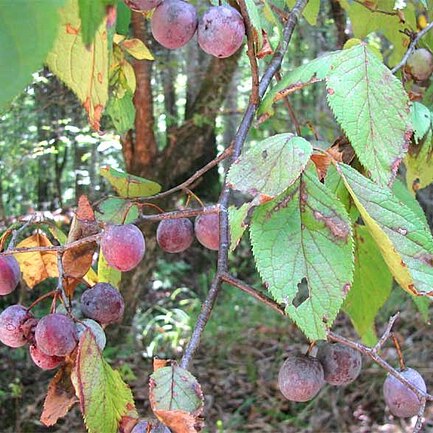Tree to 12 m, not sprouting from the roots; lvs firm, oblong to oblong-obovate, 6–10 cm, abruptly acuminate, broadly rounded at base, coarsely and usually doubly serrate with broad, acuminate, ovate-triangular teeth 1–2 mm, slightly pubescent and somewhat rugose above, permanently soft-pubescent and ± reticulate-veiny beneath; petiole usually with a pair of distal glands; pedicels usually glabrous, 8–20 mm; hypanthium glabrous or sparsely pubescent; sep narrowly oblong, 2–3 mm, pubescent on both sides; pet white, 8–10 mm; fr purplish-red, glaucous, globose or ellipsoid, 2–3 cm long; stone turgid, obovoid to subglobose. Rocky open woods; Mo. and s. Ill. to Ala. and Tex., and n. Mex., with outlying stations to O., Ky. and S.D. Apr. (P. americana var. lanata)
A small tree. It has a single trunk. The crown is open. It grows 6 m tall. The trunk is 15 cm wide. The leaves are 5-11 cm long by 3-5 cm wide. They are narrowly oval with a long pointed tip. There are fine double teeth along the edge. The leaves are yellow-green above and paler underneath. There are prominent veins underneath. The leaf stalks have 1-3 gland dots near the tip. The flowers are 19 mm long with 5 rounded white petals. There are 2-4 flowers in clusters on slender stalks. The fruit is a plum. It is 1.2-2.5 cm wide. The skin is purplish-red. It has a white bloom. The flesh is sweet. The stone is large.


